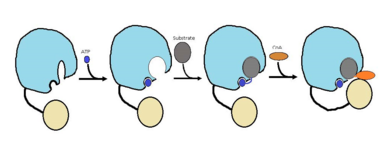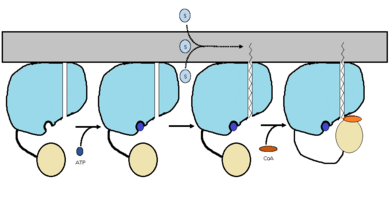Sandbox Reserved 1063
From Proteopedia
(Difference between revisions)
| Line 3: | Line 3: | ||
<StructureSection load='3R44' size='340' side='right' caption='Caption for this structure' scene=''> | <StructureSection load='3R44' size='340' side='right' caption='Caption for this structure' scene=''> | ||
== Introduction == | == Introduction == | ||
| - | ''<scene name='69/694230/Fadd13_subunits/4'>FadD13</scene>'' ''Mycobacterium Tuberculosis'' is an ACSVL (Acyl-CoA synthetases very long) peripheral membrane protein<ref>PMID: 17762044</ref>. ACS proteins activate [http://en.wikipedia.org/wiki/Lipid lipids] and [http://en.wikipedia.org/wiki/Fatty_acid fatty acids] before going into [http://en.wikipedia.org/wiki/Metabolic_pathway metabolic pathways]. FadD13 is soluble unlike other ACSVL proteins. FadD13 contains a hydrophobic tunnel for fatty acids to bind to, as well as an arginine rich lid loop that binds to the cell membrane. The binding of ATP causes structural changes promoting the binding of the hydrophobic substrates. Formation of an acyl-adenylate intermediate induces a 140 degree rotation of the small domain and binding of CoA for production of the final product, a fatty acyl-CoA thioester<ref> Kochan, G., Pilka, E.S., von Delft, F., Oppermann, U., and Yue,W.W. (2009). Structural snapshots for the conformation-dependent catalysis by human medium-chain acyl0coenzyme A synthetase ACSM2A. J. Mol. Biol. ''388'', 997-1008.</ref>. Shown below is the general mechanism for ACS proteins. | + | ''<scene name='69/694230/Fadd13_subunits/4'>FadD13</scene>'' ''Mycobacterium Tuberculosis'' is an ACSVL (Acyl-CoA synthetases very long) peripheral membrane protein<ref>PMID: 17762044</ref>. ACS proteins activate [http://en.wikipedia.org/wiki/Lipid lipids] and [http://en.wikipedia.org/wiki/Fatty_acid fatty acids] before going into [http://en.wikipedia.org/wiki/Metabolic_pathway metabolic pathways]. FadD13 is soluble unlike other ACSVL proteins. FadD13 contains a hydrophobic tunnel for fatty acids to bind to, as well as an arginine rich lid loop that binds to the cell membrane. The binding of ATP causes structural changes promoting the binding of the hydrophobic substrates. Formation of an acyl-adenylate intermediate induces a 140 degree rotation of the small domain and binding of [http://en.wikipedia.org/wiki/Coenzyme_A CoA] for production of the final product, a fatty acyl-CoA thioester<ref> Kochan, G., Pilka, E.S., von Delft, F., Oppermann, U., and Yue,W.W. (2009). Structural snapshots for the conformation-dependent catalysis by human medium-chain acyl0coenzyme A synthetase ACSM2A. J. Mol. Biol. ''388'', 997-1008.</ref>. Shown below is the general mechanism for ACS proteins. |
[[Image:FadD13 steps.png|390 px|thumb|left|Figure 1]] | [[Image:FadD13 steps.png|390 px|thumb|left|Figure 1]] | ||
* Figure 1 shows the general outline of the binding of ATP and acyl substrates to an ACSVL enzyme. This is the accepted mechanism for these types of proteins. | * Figure 1 shows the general outline of the binding of ATP and acyl substrates to an ACSVL enzyme. This is the accepted mechanism for these types of proteins. | ||
Revision as of 02:34, 20 April 2015
FadD13
| |||||||||||
References
edit references
- ↑ Watkins PA, Maiguel D, Jia Z, Pevsner J. Evidence for 26 distinct acyl-coenzyme A synthetase genes in the human genome. J Lipid Res. 2007 Dec;48(12):2736-50. Epub 2007 Aug 30. PMID:17762044 doi:http://dx.doi.org/M700378-JLR200
- ↑ Kochan, G., Pilka, E.S., von Delft, F., Oppermann, U., and Yue,W.W. (2009). Structural snapshots for the conformation-dependent catalysis by human medium-chain acyl0coenzyme A synthetase ACSM2A. J. Mol. Biol. 388, 997-1008.
- ↑ Khare, G., Gupta, V., Gupta, R.K., Gupta, R., Bhat, R., and Tyagi, A.K. (2009). Dissecting the role of critical residues and substrate preference of a Fatty Acyl-CoA Synthetase (FadD13) of Mycobacterium tuberculosis. PLoS ONE 4,e8387.
- ↑ Andersson, C.S., Lundgren, C.A.K., Magnusdottir, A., Ge, C., Weislander, A., Molina, D., Hogbom, M. (2012)The Mycobacterium tuberculosis Very-Long-Chain Fatty Acyl-CoA Synthetase: structural Basis for Housing lipid Substrates longer than the Enzyme. Cell Press,1062-1070


